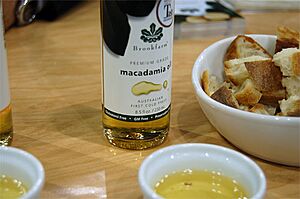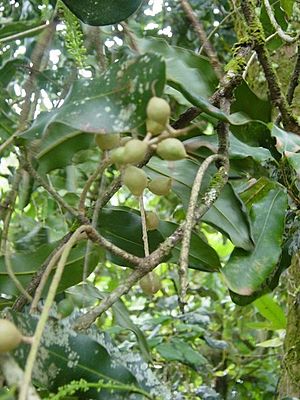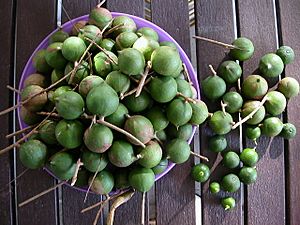Macadamia oil facts for kids
Macadamia oil comes from the nuts of the macadamia tree. This tree is originally from Australia. People use macadamia oil in many ways. You can use it for cooking, like frying food or making salad dressings. It's also found in beauty products because it can make skin soft and help perfumes smell good for longer.
Contents
Discover Macadamia Nuts
Macadamia trees are special plants from Australia. They have leaves that look a bit like holly. These trees like to grow in damp, rich soil. They can even handle some cold weather. It takes about 5 to 7 years for a young tree to start growing nuts.
The Nuts and How They Grow
The macadamia fruit has a very hard shell that protects the nut inside. The nut itself is whitish, sweet, and can be eaten raw or roasted. The trees have white or cream-colored flowers. Their leaves grow in groups of three. Farmers grow macadamia trees by planting seeds, grafting, or air layering. This means they are grown on farms to produce nuts for us to enjoy.
Some common names for these trees are the Australian nut or the Queensland nut. There are two main types:
- Macadamia integrifolia has smooth-shelled nuts.
- Macadamia tetraphylla has rough-shelled nuts.
Both types are native to Australia. Macadamia integrifolia grows in rainforests and near streams. Macadamia tetraphylla is found in parts of Queensland and New South Wales.
All About Macadamia Oil
Macadamia nuts are full of oil, usually between 65% and 75% oil. They also have some sugar. These amounts can change the color and texture of the nuts when they are roasted.
Macadamia oil is a liquid at room temperature. When it's refined, it looks clear and has a light amber color. It also has a slightly nutty smell. The oil starts to build up in the nuts when they are fully grown and their shells become hard. This happens quickly in late summer.
Macadamia oil is mostly made of healthy fats called unsaturated fatty acids. These fats are good for you. The oil is similar in both types of macadamia trees. Because of its healthy fats and no cholesterol, macadamia oil is often seen as a healthy food.
Cooking with Macadamia Oil
Macadamia oil is great for cooking, especially for frying. This is because it can handle high heat. Here are some reasons why it's a good choice for your kitchen:
- It has a lot of monounsaturated fats, up to 85%. These are healthy fats.
- You can keep it in your pantry for one to two years without needing to put it in the fridge.
- It has a high smoke point of 210 °C (410 °F). This means it can get very hot before it starts to smoke.
- Its flash point is over 300 °C (572 °F), meaning it's very safe to cook with.
Fatty Acids in Macadamia Oil
Macadamia oil contains different types of fatty acids. About 60% of it is oleic acid. It also has about 19% palmitoleic acid, and smaller amounts of linoleic acid and α-linolenic acid. The oil is very stable because it doesn't have much polyunsaturated fat. This means it doesn't go bad easily.
Properties of vegetable oils
| The nutritional values are expressed as percent (%) by mass of total fat. | |||||||||
| Type | Processing treatment |
Saturated fatty acids |
Monounsaturated fatty acids |
Polyunsaturated fatty acids |
Smoke point | ||||
|---|---|---|---|---|---|---|---|---|---|
| Total | Oleic acid (ω-9) |
Total | α-Linolenic acid (ω-3) |
Linoleic acid (ω-6) |
ω-6:3 ratio |
||||
| Avocado | 11.6 | 70.6 | 52–66 | 13.5 | 1 | 12.5 | 12.5:1 | 250 °C (482 °F) | |
| Brazil nut | 24.8 | 32.7 | 31.3 | 42.0 | 0.1 | 41.9 | 419:1 | 208 °C (406 °F) | |
| Canola | 7.4 | 63.3 | 61.8 | 28.1 | 9.1 | 18.6 | 2:1 | 238 °C (460 °F) | |
| Coconut | 82.5 | 6.3 | 6 | 1.7 | 175 °C (347 °F) | ||||
| Corn | 12.9 | 27.6 | 27.3 | 54.7 | 1 | 58 | 58:1 | 232 °C (450 °F) | |
| Cottonseed | 25.9 | 17.8 | 19 | 51.9 | 1 | 54 | 54:1 | 216 °C (420 °F) | |
| Flaxseed/linseed | 9.0 | 18.4 | 18 | 67.8 | 53 | 13 | 0.2:1 | 107 °C (225 °F) | |
| Grape seed | 10.5 | 14.3 | 14.3 | 74.7 | – | 74.7 | very high | 216 °C (421 °F) | |
| Hemp seed | 7.0 | 9.0 | 9.0 | 82.0 | 22.0 | 54.0 | 2.5:1 | 166 °C (330 °F) | |
| Olive | 13.8 | 73.0 | 71.3 | 10.5 | 0.7 | 9.8 | 14:1 | 193 °C (380 °F) | |
| Palm | 49.3 | 37.0 | 40 | 9.3 | 0.2 | 9.1 | 45.5:1 | 235 °C (455 °F) | |
| Peanut | 16.2 | 57.1 | 55.4 | 19.9 | 0.318 | 19.6 | 61.6:1 | 232 °C (450 °F) | |
| Rice bran oil | 25 | 38.4 | 38.4 | 36.6 | 2.2 | 34.4 | 15.6 | 232 °C (450 °F) | |
| High-oleic safflower oil | 7.5 | 75.2 | 75.2 | 12.8 | 0 | 12.8 | very high | 212 °C (414 °F) | |
| Sesame | 14.2 | 39.7 | 39.3 | 41.7 | 0.3 | 41.3 | 138:1 | ||
| Soybean | partially hydrogenated | 14.9 | 43.0 | 42.5 | 37.6 | 2.6 | 34.9 | 13.4:1 | |
| Soybean | 15.6 | 22.8 | 22.6 | 57.7 | 7 | 51 | 7.3:1 | 238 °C (460 °F) | |
| Walnut oil | unrefined | 9.1 | 22.8 | 22.2 | 63.3 | 10.4 | 52.9 | 5:1 | 160 °C (320 °F) |
| Sunflower | 8.99 | 63.4 | 62.9 | 20.7 | 0.16 | 20.5 | 128:1 | 227 °C (440 °F) | |
| Cottonseed | hydrogenated | 93.6 | 1.5 | 0.6 | 0.2 | 0.3 | 1.5:1 | ||
| Palm | hydrogenated | 88.2 | 5.7 | 0 | |||||




